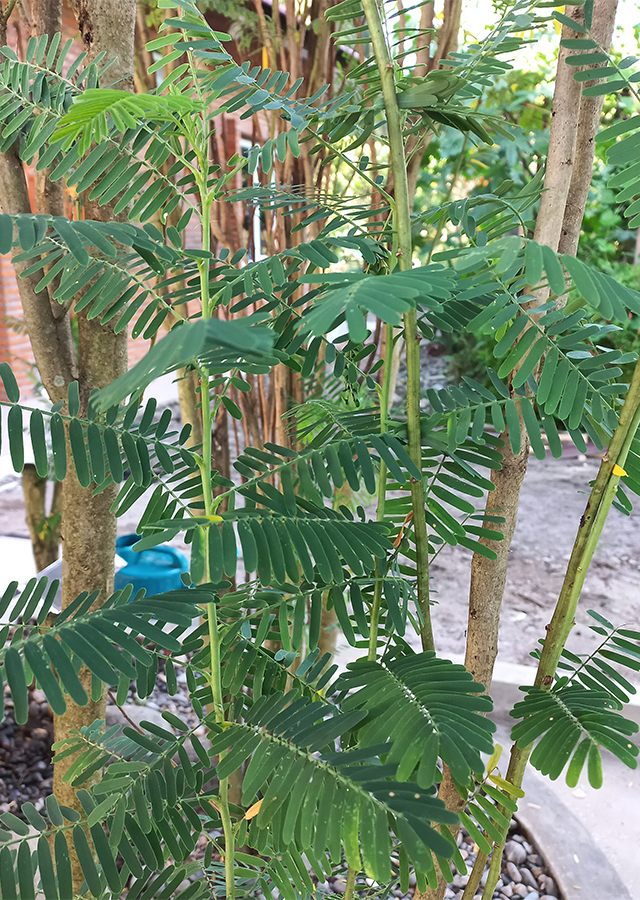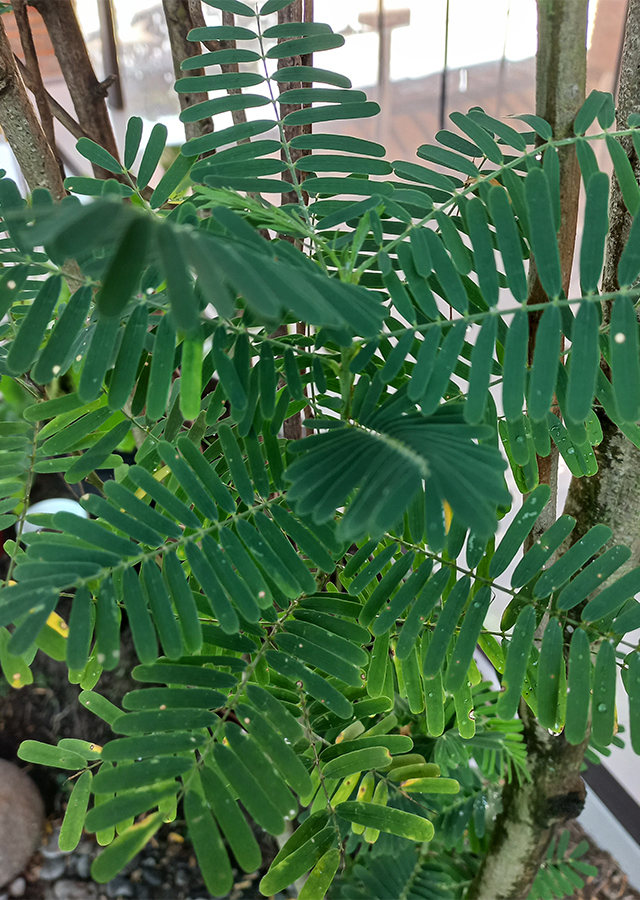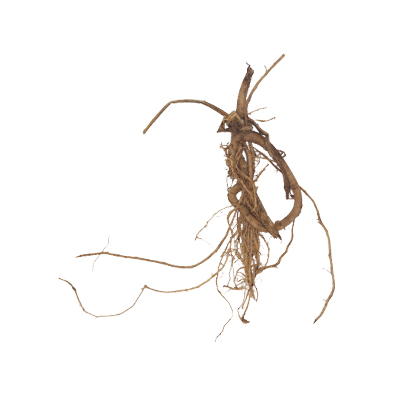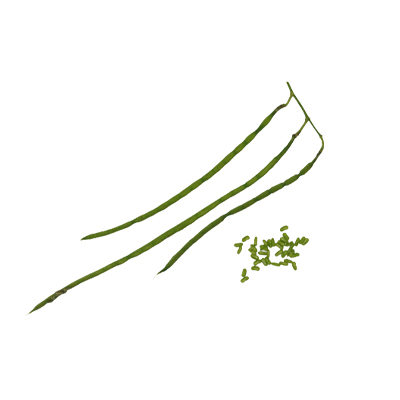Egyptian River Hemp
Sesbania sesban (L.).Merr.
Fabaceae
Location in our garden
Principal



Synonym
Aeschynomene sesban L.
Coronilla sesban (L.) Moench
Emerus sesban (L.) Hornem.
Habitus
Shrubs. Shrub or small tree with a narrow crown, perennial, it can grow from 1 - 7 metres tall.
Part Used
Leaves
Seeds
Bark
Roots
Growing Requirements
Full Sunshine
Habitat
Riverbanks
Roadside
Terrestrial
Overview
Sesbania sesban (L.) Merr. is accepted, and its native range is Tropical & S. Africa, Arabian Peninsula, Indian Subcontinent. It is cultivated widely for fodder and forage, and is reported as an invasive species in Israel and the U.S. state of Hawaii. It has become naturalized in many of the countries where it is cultivated, and is characterized by very rapid early growth. S. sesban is mainly used for fodder. The leaves and branches are high in protein (20-25%) and give high digestibility for ruminants, but are not recommended for feeding to monogastric animals such as rabbits and pigs. S. sesban has significant anti-inflammatory potential and may have "antibiotic, anthelmintic, anti-tumour, and contraceptive properties as well as special properties in Ayurvedic medicinal practices”. It is reported to be effective in the treatment of scorpion stings, boils, and abscesses as well as a repellent of the tsetse fly. S. sesban is used, to treat "sore throat, gonorrhoea, syphilis, spasmodic fits in children, and jaundice during pregnancy."
Vernacular Names
Common sesban, Egyptian pea, Egyptian rattle pod, Egyptian sesban, Frother, River bean (English), Palisandro (Cuba), Tamarindillo (Spanish), Sesbanie d'Egypte (French), Seseban, Torero (Arabic), Yin du tian jing (Chinese), Snao kook (Cambodia), Añil francés ( Cuba), Gelbe Baumwisterie (Germany), Chithagathi, Chuchu-rangmei, Jaint, Jayant, Jayantika, Karunchembai, Nadeyi, Raishingin, Rrawsa, Samintha, Shevri, Vaijayanti (India), Janti, Jayanti, Puri (Indonesia), Sapao lom (Laos), Yay-tha-kyee, Yethugyi (Myanmar), Katodai, Katuray (Philippines), Riverbontjie, UmQambuqweqwe, Umsoksok (South Africa), Chittakatti, Karunchembai (Sri Lanka), Champai, Sami, Saphaolom (Thailand), Mubimba, Muzimbandeya (Uganda), Dien-dien (Vietnam).
Agroecology
A plant of the subtropics, also succeeding at higher elevations in the tropics, being found at elevations of 100 - 2,300 metres. It grows best in areas where annual daytime temperatures are within the range 18 - 28 °C, but can tolerate 10 - 45 °C. When dormant, the plant can survive temperatures down to about -5 °C, but young growth can be severely damaged at -1 °C. It prefers a mean annual rainfall in the range 800 - 2,000 mm, but tolerates 350 - 2,500 m. Requires a sunny position. Tolerates saline, acidic and alkaline soils. The plant has an outstanding ability to withstand waterlogging and is ideally suited to seasonally flooded environments. When flooded, it initiates floating, adventitious roots and protects its stems, roots and nodules with spongy, aerenchyma tissue. It also shows some tolerance to moisture stress and tolerates soil alkalinity and salinity to a considerable degree. Prefers a pH in the range 5 - 7, tolerating 4 - 9,9.
Morphology
- Branches pubescent, glabrescent, internodes often 0.5-2.5 cm, nodes conspicuously gibbous. Stipules triangular-lanceolate, 3-4 mm, caducous, pubescent.
- Leaves 20-40-foliolate; petiole and rachis appressed pubescent, more so at petiole base; rachis 4-10 cm; petiolules appressed pubescent; stipels acerose; leaflet blades oblong to linear, 1.3-2.5 cm × 3-4(-6) mm, both surfaces with purplish black glands, abaxially sparsely appressed pubescent when young but glabrescent, adaxially glabrous or glabrescent, midvein evident on both surfaces, base obliquely rounded, apex rounded to retuse and mucronate.
- Flowers racemes 4-10-flowered; peduncle 8-10 cm, slender, pubescent, glabrescent; bracts linear-lanceolate, caducous, abaxially sparsely appressed pubescent. Pedicel ca. 8 mm, slender, pubescent when young; bracteoles smaller than bracts, caducous. Calyx campanulate; teeth shortly triangular, inside appressed pubescent to glabrescent. Corolla yellow or calyx and standard purplish black and wings and keel partly purplish black or red; standard transversely elliptic, 1.1-1.3 cm, wider than long, with a 4-5 mm claw, with a S-shaped callus ca. 2 mm, basally decurrent to lamina, widened in middle, and distinct and acuminate to obtuse at apex, base subcordate, apex emarginate; wings oblong, 1-1.2 cm, with a curved ca. 4 mm claw, base inconspicuously auriculate, apex rounded; keel nearly semicircular, 6-8 × 5-7 mm, lamina base narrower than apex and with a triangular short auricle, claw ± as long as calyx. Stamen tube 8-10 mm; anthers ellipsoid. Ovary glabrous; style ca. 5 mm, glabrous; stigma globose.
- Fruiting legume contorted when young but straight or slightly curved at maturity, subterete, 15-23(-30) cm × 3-4 mm, ca. 5 mm between transverse septa, base often with a marcescent calyx, apex beaked.
- Seeds 20-40 per legume, subterete, 3-4 × ca. 2 mm, slightly compressed; hilum rounded and concave.
Cultivation
- S. sesban reproduces primarily from seed although it can be vegetatively propagated.
- Seed: requires pre-treatment to soften the hard seedcoat and allow the ingress of water. This can be done by soaking the seed in a small amount of nearly boiling water (which cools down quickly and does not cook the seed) and then soaking the seed for 12 - 24 hours in warm water. Alternatively, a small area of the seed coat can be abraded, being careful not to damage the embryo. The germination rate of treated seed is about 65% in about 16 days. Seed storage behaviour is orthodox. Viability can be maintained for 2 years in open storage at room temperature.
Chemical Constituents
Saponins, tannin, polyphenolics, oleanolic acid, stigmastane-5.24(28)-diene- 3β-O-β-D-galactopyranoside, galactomannan, phenols flavonoids, anthocyanins, campesterol, ß-sitosterol, cyanidin, delphinidin glucosides, alpha-ketoglutaric, oxaloacetic, pyruvic acids, alkaloids, phytosterol, phenol, fixed oil, flavonols, flavonoids.
Traditional Medicinal Uses
- Poultice of leaves promote suppuration of boils and abscesses and absorption of hydrocoele and inflammatory rheumatic swellings.
- Juice of fresh leaves used as anthelmintic.
- Seeds used for diarrhea and excessive menstrual flow; also for reducing splenic enlargement.
- Ointment used for itches and various skin eruptions.
- Juice of bark also used for skin eruptions and itching.
- Bruised roots made into paste, applied to scorpion stings.
- In India, used to relieve rheumatic pains. Roots used for inflammation, fever, ulcers, leucoderma, and diabetes.
- In Ethiopia used for phytoremediation, anti-inflammatory, antioxidant, livestock feed, antimicrobial, abortifacient, and antifertility agent. Leaves and young twigs used for milk production enhancement.
- In Tanzania, used to treat sore throat, gonorrhea, syphilis, spasmodic fits in children, and jaundice during pregnancy.
- In Thai traditional medicine, the herb is used as a sleeping aid.
Part Used
Reference Sources
- Fern, Ken. Useful Tropical Plants. 2021. Sesbania sesban. http://tropical.theferns.info/viewtropical.php?id=Sesbania+sesban. 18-10-2021.
- Stuartxchange. Philippine Medicianal Plants. 2015. Sesban. http://www.stuartxchange.org/Sesban.html. 18-10-2021.
- National Park. Flora Fauna Web. 2019. Sesbania sesban (L.) Merr. https://www.nparks.gov.sg/florafaunaweb/flora/5/7/5751. 18-10-2021.
- Cabi. 2021. Sesbania sesban (sesban). https://www.cabi.org/isc/datasheet/49466. 18-10-2021.



